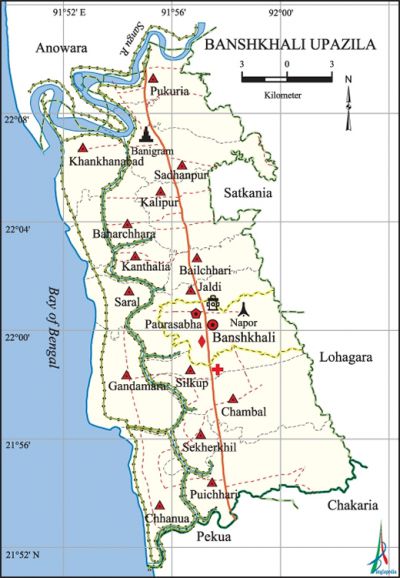Banshkhali Upazila
Banshkhali Upazila (chittagong district) area 376.90 sq km, located in between 21°53' and 22°11' north latitudes and in between 91°51' and 92°03' east longitudes. It is bounded by anowara upazila and Sanguriver on the north, chakaria upazila on the south, lohagara and satkania upazilas and wide hilly regions on the east, bay of bengal, Kutubdia channel and kutubdia upazila on the west.
Population Total 391320; male 205482, female 185838; Muslim 342347, Hindu 44311, Buddhist 195, Christian 3882 and others 585.
Water bodies Main river: sangu; Jalkanda canal, Sheker beel and Kutubdia channel are notable.
Administration Banshkhali Thana was formed in 1958 and it was turned into an upazila in 1983.
| Upazila | ||||||||
| Municipality | Union | Mouza | Village | Population | Density (per sq km) | Literacy rate (%) | ||
| Urban | Rural | Urban | Rural | |||||
|
1 |
15 |
72 |
113 |
18645 |
372675 |
1038 |
36.3 |
31.6 |
| Upazila Town (out side of municipality) | ||||||||
|
Area (sq km) |
Mouza |
Population |
Density |
Literacy rate (%) | ||||
|
8.86 |
1 |
18645 |
2104 |
38.2 | ||||
| Union | ||||
| Name of union and GO code | Area (acre) | Population | Literacy rate (%) | |
| Male | Female | |||
|
Katharia 50 |
2710 |
10099 |
9350 |
28.82 |
|
Kalipur 44 |
5694 |
14906 |
13923 |
37.45 |
|
Khankhanabad 56 |
6560 |
15267 |
13060 |
30.17 |
|
Gandamara 31 |
7343 |
15165 |
14250 |
21.39 |
|
Chambal 18 |
8848 |
16593 |
14830 |
24.39 |
|
Chhanua 25 |
4991 |
12225 |
10760 |
27.52 |
|
Jaldi 37 |
7022 |
15780 |
14698 |
34.75 |
|
Puichhari 63 |
10812 |
16838 |
15788 |
27.24 |
|
Pukuria 69 |
7578 |
13925 |
12225 |
39.41 |
|
Bailchhari 12 |
3157 |
5913 |
5183 |
37.70 |
|
Baharchhara 06 |
5496 |
17521 |
14921 |
32.70 |
|
Silkup 94 |
2781 |
9778 |
9861 |
21.76 |
|
Sekherkhil 88 |
2602 |
9810 |
8830 |
25.17 |
|
Saral 82 |
7499 |
19311 |
16817 |
19.32 |
|
Sadhanpur 75 |
7091 |
12351 |
11342 |
37.84 |
Source Bangladesh Population Census 2001, Bangladesh Bureau of Statistics.

Archaeological heritage and relics Baksi Hamid Mosque (1558), Jatebi Jami Mosque, Nabi Mosque (eighteenth century), Nim Kalibari (1710), Sikh Temple (Banigram).
History of the War of Liberation During the war of liberation the Pak army brutally killed 75 persons on 19 May 1971. Besides, they set many houses on fire at villages Jaldi, Banigram and Kalipur. The Pak army also killed 89 freedom fighters at village Naporaon on the southern extremity of Banshkhali. They also caused heavy destruction on the eastern extremity of Banshkhali. They killed freedom fighters Md. Forhad Chowdhury, Sujankanti Das, Flight Sergent Mahiul Alam, Abu Saiyed and Mohammad Elias Chowdhury at village Boilchhari.
Marks of the War of Liberation Mass killing site 2; mass grave 1 (adjacent to the Banshkhali Degree College).
Religious institutions Mosque 464, temple 52, church 1, kyang 2. Noted religious institutions: Habibullah Khan Jami Mosque, Katebi Jami Mosque, Rishidham Hermitage and Jaldi Dharmo Ratno Vihara.
Literacy rate and educational institutions Average literacy 29.5%; male 33.8%, female 24.8%. Educational institutions: college 3, secondary school 25, primary school 140, community school 10, satellite school 10, kindergarten 5, madrasa 215. Noted educational institutions: Banshkhali Degree College (1967), Alaoul Degree College, Paschim Banshkhali Coastal College (1995), Banigram Sadhanpur High School (1917), Banshkhali Pilot High School (1932), Kalipur Ejaharul Haque High School (1942), Sadhanpur Polli Unnayan High School (1942), Chambal High School (1946), Banigram Primary School (1881), Jaldi Hossainia Madrasa (1967).
Cultural organisations Library 1, club 75, women's organisation 9, play ground 24.
Main sources of income Agriculture 58.73%, non-agricultural labourer 6.68%, commerce 11.42%, transport and communication 1.70%, industry 0.50%, service 6.78%, construction 0.58%, religious service 0.43%, rent and remittance 1.51% and others 11.67%.
Ownership of agricultural land Landowner 47.16%, landless 52.84%; agricultural landowner: urban 40.34% and rural 47.53%.
Main crops Paddy, jute, tea, potato, ginger, betel leaf, vegetables.
Extinct or nearly extinct crops Sesame, mustard seeds.
Main fruits Mango, jackfruit, litchi, banana, papaya, watermelon, lemon, guava.
Fisheries, dairies and poultries Fishery 34, poultry 86, hatchery 25.'
Communication facilities Pucca road 173 km, semi-pucca road 47 km, mud road 712 km.
Extinct or nearly extinct traditional transport Palanquin, bullock cart.
Noted manufactories Small industry 10, saw mill 15, ice factory 3, brickfield 5, welding factory 6.
Cottage industries Goldsmith, blacksmith, potteries, weaving.
Hats, bazars and fairs Hats and bazars are 44, fairs 6, most noted of which are Beyan Bazar, Ramdas Munsir Hat, Mosharraf Ali Hat, Chowdhury Hat, Ishawar Babur Hat, Bahaddar Hat, Sadar Amin Hat, Darogar Hat and Kumvo Mela (Rishidham), Sairjabrata Mela, Rawthjatrar Mela (Banigram), Uttarayan Sangkrantir Mela and Balikhelar Mela.
Main exports Betel leaf, litchi, tea, ginger, salt, shrimp, sea fish.
Access to electricity All the wards and unions of the upazila are under rural electrification net-work. However 14.14% dwellings have access to electricity.'
Sources of drinking water Tube-well 94.47%, pond 2.76%, tap 0.88% and others 1.89%.
Sanitation 28.55% (rural 27.64% and urban 45.57%) of dwelling households of the upazila use sanitary latrines and 62.36% (rural 63.68% and urban 37.67%) of dwelling houses use non-sanitary latrines; 9.09% of households do not have latrine facilities.
Health centres Upazila health complex 1, family welfare centre 3, satellite clinic 3.
NGO activities CARE, proshika, brac, Uddipan, Shanirvor. [Ujjal Bishwas]
References Bangladesh Population Census 2001, Bangladesh Bureau of Statistics; Cultural survey report of Banshkhali Upazila 2007.
